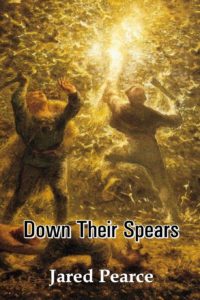 Guest post by Jared Pearce
Guest post by Jared Pearce
If there wasn’t a lot of talk, the talk was consistent: where is the Mormon Epic? I was at Brigham Young University in the late nineties, and all the chatter about when the Mormon Shakespeare would arrive or how the Mormon Milton would produce the poem that captured the essence of Mormonism for the world’s readers seemed to culminate in a graduate course focused upon English Romantic poets’ attempts to create an epic. We read a lot of Wordsworth, a good chunk of Byron and Keats, and others, all the while having to confess that the Romantics had trouble epic-building in Milton’s shadow. It seemed Dr. Peter J. Sorenson made several hints that Mormon stories—taken from the Book of Mormon or from Church History—would make for fine epic poems.
I wasn’t all that interested, but I did feel swept up in the spirit of finding a story big enough, a form powerful enough, to share that image. After a year of focusing on Tennyson’s In Memoriam, I left BYU for the South. I didn’t think much of writing long poems.
Over the next few years I wasn’t keeping close correspondences with my former BYU instructors, but we did touch base sometimes. Sometimes Sorenson and others would hint at projects they were working on, and sometimes they’d even share some of their drafts. I remember reading passages from a long poem Sorenson was working on, The Mormoniad, and feeling very impressed with it.
Then, at one point, I decided to try a long, Mormon poem. I don’t recall the circumstances, but I think I just wanted to try something against the lyrics I had been writing. I started fishing for ideas and scenes, and eventually started drafting-out a plot and form. In those early trials Sorenson asked if I was using Milton for a model, and I said, No—Blake. He seemed pleased that I would try to avoid following Milton’s modes and go for a model that might speak in a different way, and I was pleased that he was pleased. I think that was our last conversation.
As I neared the end of planning my poem, my sister, then working at a wonderful independent bookshop in Santa Cruz, asked what books I couldn’t get and wanted. I asked for a copy of James Merrill’s Changing Light at Sandover. She rounded me up a copy, and that book totally rearranged my thinking toward my poem: Merrill, thirty years before my poem, had stolen one of my central images, and had done so with greater clarity, power, and thrift. Well, you put yourself against the masters, and you’re bound to get your nose broke.
I rewrote my poem, trying to share a Mormon idea in a Blakeian tone with a Tennysonian arch and a Merrillian versatility. I read all kinds of things for help: Black Athena, Ancient Babylonian Contracts, A Vision, A Brief History of Time. My friends offered their reviews, often critical. My family could often make nothing of the scenes and sections. I asked a friend, Katy Wheeler, to supply some pictures, and she created wonderful images, including two stunning engravings. I got the poem together as the central piece in my poetry dissertation, and that was about it.
Down Their Spears (the title is taken from a line in Blake’s, “The Tyger”) is a Latter-Day Saint cosmogony. Each of the poem’s nine sections is told by a different speaker in a different place at a different time, from sixth century BCE India to nineteenth century Illinois, and each speaker offers a different part of the myth that weaves religious, historical, and mystical characters, scenes, and ideals to tell the story of the history of the universe through a novel, Mormon perspective.
Every once in a while I’d send a section to a magazine or share a section at a conference, and editors were sometimes complimentary in rejecting it for publication, and often conference audiences were complimentary in hearing a section.
After the release of my first book, The Annotated Murder of One, I was approached by an editor who wanted to know if I had anything else ready to go. I offered him what is now Down Their Spears. It is not a Mormon Epic, and I am not a Mormon Milton. For me, Down Their Spears is a poem that celebrates how Mormonism functions to draw all truth into one whole. The point of the poem was to have reading, viewing, and thinking fun.
[The following passage is from section 8. The speaker is a priest engaged in the defacement of the sun pyramid at Teotihuacan sometime around the year 385. This passage offers the story of Lucifer’s temptation of Eve: Mictlan, who has already eaten the fruit himself, tempts Mayahuel to eat the fruit so as to further his plan for the extension of creation.]
# # #
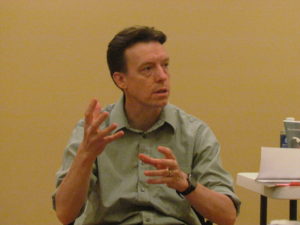 Jared Pearce’s poems have been shared in the United States, the United Kingdom, Australia, Asia, and India, online and in print. His books include The Annotated Murder of One (Aubade, 2018) and Down Their Spears (Cyberwit, 2021). He lives and writes in Iowa, United States.
Jared Pearce’s poems have been shared in the United States, the United Kingdom, Australia, Asia, and India, online and in print. His books include The Annotated Murder of One (Aubade, 2018) and Down Their Spears (Cyberwit, 2021). He lives and writes in Iowa, United States.

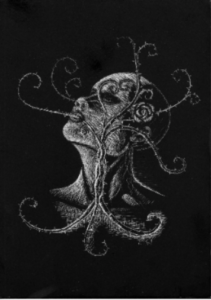
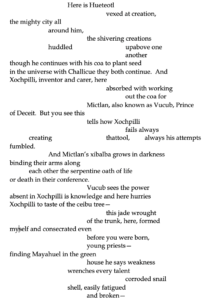
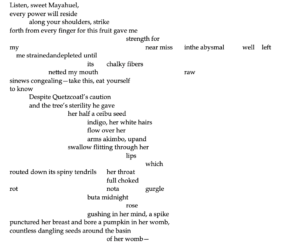
Here are some Mormon epic poetry links:
Peter J. Sorensen’s 2003 AML presentation about his epic poem “Mormoniad”.
https://www.associationmormonletters.org/aml-publications-documents/aml-annuals/aml-annual-2003/
A discussion of Sorensen’s “Mormoniad” and epic poetry
https://motleyvision.org/2004/08/10/criticism-the-book-of-mormon-as-epic/
Another discussion of epic poetry
https://motleyvision.org/2009/04/21/there-is-mormon-epic-poetry/
A 2009 issue of Irreantum, with an essay by Michael Collings on epic poetry, and some contemporary epic poems
https://www.associationmormonletters.org/aml-publications-documents/irreantum/irreantum-volume-8-no-1-winter-2006/
This is beautiful, Jared.
My favorite part: “her white hairs flow over her arms akimbo,
up and swallow fitting through her lips which routed down its spiny tendrils
her throat full choked rot
not a gurgle but a midnight
rose gushing in her mind…”
Your use of language, phrasing and pace are satisfying. I also enjoyed your weaving of the two stories. (I had to look up all the names and a few words- so, I think I’m smarter now, too.)
Good work!
I had no idea that the LDS literary tradition had a whole branch of Epic Poetry! A fun new facet to explore! I am looking forward to diving into this in the coming weeks and months with high hopes.
https://www.amazon.com/gp/product/B07SD7SQC8/ref=dbs_a_def_rwt_bibl_vppi_i0
https://www.associationmormonletters.org/2022/02/a-call-for-moral-adult-lds-fiction/#comment-150734
Jared, the use of enjambment and the way you’ve cut and placed your lines here is spectacular. This poem feels like multiple small poems in one, longer piece. I think I could read it again and again and, upon each reading, find something new. Isn’t that the point of poetry? Maybe.
The detail of the blog is and how the processes really help kind of understand the piece that is wrote. It takes awhile for the process of writing to kind of click. You can start a piece and then come back to it at some point. It also talks about how you can play with the wording.
It talks about how the processes of writing can be difficult. The wording takes time and it can be difficult sometimes. You do not need to constantly work on it. You can take a break and come back to it.
I enjoy what you said about the writing process, “put yourself against the masters, and you’re bound to get your nose broke”. Saying that showed the difficulties you encountered while writing. While writing is not easy and you had many ups and downs, you didn’t give up on your envisioning of your literature.